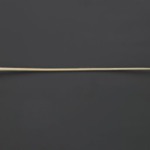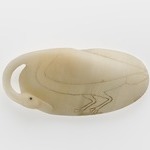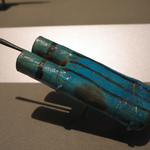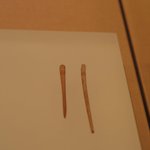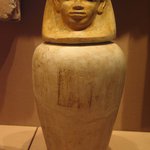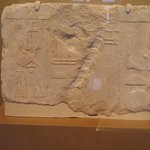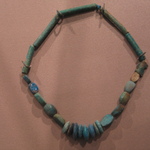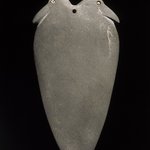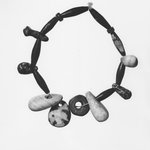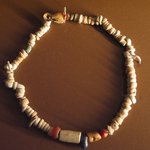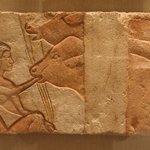

Male Statuette, ca. 3800–3650 B.C.E. Ivory, 11/16 x 7 1/16 in. (1.8 x 17.9 cm). Brooklyn Museum, Charles Edwin Wilbour Fund, 35.1268. Creative Commons-BY (Photo: Brooklyn Museum, 35.1268_front_PS6.jpg)

Male Statuette, ca. 3800–3650 B.C.E. Ivory, 11/16 x 7 1/16 in. (1.8 x 17.9 cm). Brooklyn Museum, Charles Edwin Wilbour Fund, 35.1268. Creative Commons-BY (Photo: Brooklyn Museum, 35.1268_back_PS6.jpg)

Male Statuette, ca. 3800–3650 B.C.E. Ivory, 11/16 x 7 1/16 in. (1.8 x 17.9 cm). Brooklyn Museum, Charles Edwin Wilbour Fund, 35.1268. Creative Commons-BY (Photo: Brooklyn Museum, CUR.35.1268_erg3.jpg)
Male Statuette
Egyptian, Classical, Ancient Near Eastern Art
On View: Pre-Dynastic, Egyptian Galleries, 3rd Floor
This flat, extremely elongated figure wears only a penis sheath. The arms, now mostly lost, originally extended down along the figure’s body. Inlays of another material once filled the vacant eyeholes.
MEDIUM
Ivory
DATES
ca. 3800–3650 B.C.E.
PERIOD
Predynastic Period, early Naqada I Period
DIMENSIONS
11/16 x 7 1/16 in. (1.8 x 17.9 cm) (show scale)



COLLECTIONS
Egyptian, Classical, Ancient Near Eastern Art
ACCESSION NUMBER
35.1268
CREDIT LINE
Charles Edwin Wilbour Fund
PROVENANCE
Archaeological provenance not yet documented; by 1910, acquired by Friedrich Wilhelm von Bissing; before 1934, acquired from von Bissing by the Scheurleer Museum, the Hauge, the Netherlands; 1935, purchased from the Scheurleer Museum by the Fondation Egyptologique Reine Elisabeth; 1935, purchased from the Fondation Egyptologique Reine Elisabeth by the Brooklyn Museum.
Provenance FAQ
CATALOGUE DESCRIPTION
Free-standing elongated ivory figure of a man wearing a so-called Libyan sheath. Eyes circular and originally inlaid. Prominent ears, elongated face. Legs entirely in the round. Few details indicated on body. Arms, now missing, were very elongated, extending down well onto thighs.
Condition: Arms missing. Inlay of eyes missing. Back of head missing.
EXHIBITIONS
MUSEUM LOCATION
This item is on view in Pre-Dynastic, Egyptian Galleries, 3rd Floor
CAPTION
Male Statuette, ca. 3800–3650 B.C.E. Ivory, 11/16 x 7 1/16 in. (1.8 x 17.9 cm). Brooklyn Museum, Charles Edwin Wilbour Fund, 35.1268. Creative Commons-BY (Photo: Brooklyn Museum, 35.1268_front_PS6.jpg)
IMAGE
front, 35.1268_front_PS6.jpg. Brooklyn Museum photograph, 2011
"CUR" at the beginning of an image file name means that the image was created by a curatorial staff member. These study images may be digital point-and-shoot photographs, when we don\'t yet have high-quality studio photography, or they may be scans of older negatives, slides, or photographic prints, providing historical documentation of the object.
RIGHTS STATEMENT
Creative Commons-BY
You may download and use Brooklyn Museum images of this three-dimensional work in accordance with a Creative Commons license. Fair use, as understood under the United States Copyright Act, may also apply.
Please include caption information from this page and credit the Brooklyn Museum. If you need a high resolution file, please fill out our online application form (charges apply).
For further information about copyright, we recommend resources at the United States Library of Congress, Cornell University, Copyright and Cultural Institutions: Guidelines for U.S. Libraries, Archives, and Museums, and Copyright Watch.
For more information about the Museum's rights project, including how rights types are assigned, please see our blog posts on copyright.
If you have any information regarding this work and rights to it, please contact copyright@brooklynmuseum.org.
RECORD COMPLETENESS
Not every record you will find here is complete. More information is available for some works than for others, and some entries have been updated more recently. Records are frequently reviewed and revised, and we welcome any additional information you might have.








